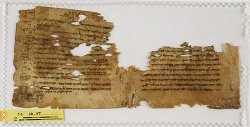Cambridge, University Library, T-S C6.117 + Westminster College, Talmudica I.110
Origins
Probably Byzantine, 11-12 c.
Provenance
Ben Ezra Synagogue, Fostat, Egypt. Taken to Cambridge by S. Schechter, 1896–97
Contents
A sequence of mainly unconnected philological and exegetical notes on the first two books of the Torah, grouped according to the liturgical readings.
Codicology
Eight leaves of parchment, together constituting an almost complete quire. Cambridge, T-S C6.117 (leaves 1 and 8): Two leaves of parchment, conjoined. Badly mutilated and stained. Large parts of the text are missing. Dimensions overall: height 11.8 cm., width of sheet 26.4 cm. Written space approximately 8 cm. x 9 cm. Pricked and scored. Westminster College, Talmudica I.110 (leaves 2 to 7): Six leaves of parchment, conjoined in pairs. Badly stained and mutilated in places, but very little text is lost. Dimensions overall: 11.3–12.9 cm. x 24.3–26.3 cm. Written space: 7.8–8.8 cm. x 8.8–9.9 cm. Pricked and scored. The leaves have been numbered twice in Arabic numerals, from 12–17 (in bottom right-hand corner) and from 7–12 (at the top, generally at the left).
Palaeography
Small, fairly neat Hebrew hand. Pointing is used occasionally and not systematically: it is used for Greek words (though not always); for Hebrew words to resolve ambiguity. There is a heavy use of ligatures; abbreviation is common, and indicated by a point above the last letter. 'Adonai' is a triangular arrangement of three 'yods' followed by an oblique stroke. Punctuation: for a minor break a superior dot; for a major break two dots, followd by an oblique zig-zag and a space at the end of a 'sidra', which is also marked by the lettes 'sd' in the right margin. The end of a book is marked by a 'spr' in the right margin. There are little rings above certain letters and in the margin, and in one passage (fol. 5r) 'p' is several times written above the name of Moses. In addition to the Greek glosses in Hebrew characters which form part of the text, there are some interlinear glosses in Greek in Hebrew characters, and also some in Greek characters. These are written in a modified uncial hand which is found in several other Cairo Genizah fragments.
Bibliography
de Lange, Nicholas, Greek Jewish texts from the Cairo Geniza, Tübingen, Mohr Siebeck, 1996.
Ta-Shma, Israel M. , Byzantine Bible commentary from the turn of the 10th–11th century’ [in Hebrew], Kneset mehqarim: ‘Iyyunim bassifrut harabbanit biyemey habbeynayim [Studies in medieval rabbinic literature: Italy and Byzantium], 3, Jerusalem, 2005, 241–58.

